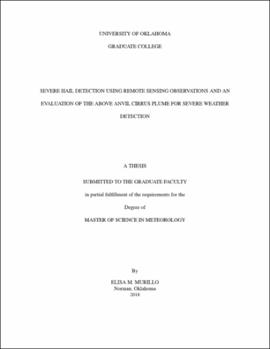| dc.description.abstract | This thesis undergoes a comprehensive comparative analysis to address two main objectives: a) Thoroughly assess available radar, satellite, and lightning based products’ ability to identify hail events and size, and b) quantify the relationship between AACPs and severe weather. Radar observations have been used in an abundance of studies aiming to identify severe weather hazards. However, due to historical reporting limitations, hail events have not been studied as extensively as other hazards. In the contiguous US, real-time analysis and detection of severe storms is largely conducted using ground-based radar observations, especially those from the operational Next Generation Weather Radar network (NEXRAD), which provides three-dimensional information on the physics and dynamics of storms at 5-min intervals. Recent NEXRAD upgrades to higher resolution and dual-polarization capabilities (completed in 2013) have provided improved capability to discriminate between hydrometeor types in real time. Additionally, new generation geostationary satellite observations (e.g. GOES-16) have greater spatiotemporal resolution than their predecessors, leading to significant changes in the utility of satellite observations.
Improved satellite observations also enable better identification of above anvil cirrus plumes (AACPs), which have been identified in satellite imagery for decades. AACPs are generated from intense tropopause penetrating updrafts and gravity wave breaking. AACPs are often evident during severe weather outbreaks and, due to their prominence, have been studied for several decades.
Thorough assessment of established products’ ability to identify hail occurrence and size has been uncommon. Additionally, current published research indicates that the AACP signature is one of the strongest indicators of a severe storm depicted by visible and IR satellite imagery. Despite the extensive research devoted to the AACP, there is lingering uncertainty regarding how these processes are depicted by datasets routinely used in operations and how AACP recognition can augment severe storm identification.
For hail detection assessment, we compare the most commonly used objective hail identification methods with less common approaches, focusing on quantitative metrics from both satellite and radar observations over the CONUS. We find that HDR below the melting level (BML), maximum estimated hail size (MESH), and vertically integrated liquid (VIL) density provide the best hail event indication, while a combination of either MESH or VIL density combined with HDR BML provide the best hail-producing storm discrimination. The MESH power relation was also refit to the study’s report dataset, and outperformed the Witt et al. (1998a) MESH for the maximum estimated hail size.
AACP and non-AACP storms are linked with storms, National Weather Service warnings, and severe weather. AACP storms were shown to be much more likely to be severe than non-AACP storms, and the majority of significant severe weather reports are produced by AACP storms. Additionally, the ability of National Weather Service (NWS) warnings with and without AACP information to detect storms that produced 2+ inch hail was assessed. It was found that the addition of AACP identification markedly increased the discrimination ability of these storms. | en_US |
